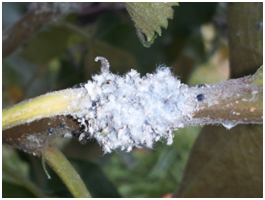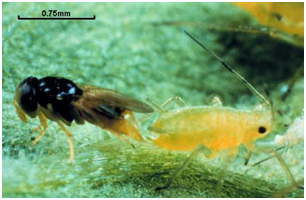- Peach
- Apple
- Blueberry
- Scouting Calendar
- Trap Counts
Peach
Oriental Fruit Moth (OFM): Oriental Fruit Moth (OFM): As of 4/29 we have accumulated 136 DD in southern counties. In northern counties 40 DD have accumulated. The first of two applications for OFM should be made between 5/2 and 5/5. The OFM target in northern counties is at least a week off.
Growers who wish to employ mating disruption for OFM should begin placing ties or including sprayable pheromone in cover sprays once the first generation flight “bottoms out” as indicated by trap captures. This should be during the first to second week of May. Populations vary from orchard to orchard. See the production guide for more information regarding mating disruption for OFM.
Green Peach Aphid (GPA): Aphid colonies are present in very few orchards; no blocks in southern counties have populations which are above a treatment threshold at this time. Only very low populations were seen in northern counties.
Thrips including western flower thrips: If thrips are found feeding in shucks, include effective materials such as Delegate and Lannate.
Plum Curculio (PC): PC adults usually begin egg laying once the fruit is out of the shuck in late April or early May. Where control is poor fresh egg scars can be found on border rows, especially near wooded or trashy areas. Preferred materials that offer PC control now are Actara, Avaunt, and Imidan. If using high rates of a neonicotinoid (i.e. Actara, Belay, Assail), be aware that there is a synergistic effect when used in tank mixes with DMI materials (i.e. Rally) with regard to bee toxicity. If pyrethroids are being used, then high rates are advisable, since low rates often do not control this insect, especially in hot weather. Where PC is a problem, growers should rotate away from pyrethroid insecticides if possible.
Stink Bugs and Other Catfacing Insects: These pests will become more of an issue as temperatures warm and mowing and other ground cover activities become more common. General spray timing at this time of year should still be targeted for Oriental Fruit Moth and/or Plum Curculio (PC). Most materials, except the diamides (Altacor, Belt, Tourismo) used for these pests will have some efficacy for plant bugs.
Brown Marmorated Stink Bug (BMSB): BMSB are starting to move out of their overwintering sites, but no activity has been seen in agricultural areas yet.
Peach Diseases: Once the shucks are completely off growers can safely switch to sulfur based programs for brown rot control. Where peach scab has been a problem, coverage with captan or another very effective scab control material should be continued. Where rusty spot has been a problem, fungicide or biorational programs targeting this disease should continue until pit hardening which usually occurs about the first or second week in June.
Apple
Apple Scab, Powdery Mildew (PM) and Cedar Apple Rust (CAR): Overwintering ascospores are now 93% mature in southern counties as of 4/29. The wetting period on 4/29 was likely a severe infection period.
Fire Blight: Blossom sprays using antibiotics should be applied anytime temperatures are 65° F or above and the relative humidity is 60% or above even where most bloom is over. In southern counties, blocks of particular concern are Rome, Gala and other cultivars that have a propensity to produce “rat-tail” blooms. Refer to the production guide for recommended materials and rates. Fire Blight is not modeled in the same way as scab. Heat units, tree phenology, dews, leaf wetness, cultivar, rootstock, and short or severe storms and/or hail all play a roll. Check the NEWA site for local predictions.
Plum Curculio (PC): See peach section above.
Wooly Apple Aphid (WAA): Normally we don’t see wooly apple aphids until late spring. However, Suzanne Solnar-Fligler at the Snyder Farm and Win Cowgill, observed an early colony in a research block of Fuji. This block was heavily infested last year, so it is no surprise that it is the first block where we see WAA in 2013. WAA for the most part, overwinter on apple roots in the nymph stage. Sometimes it can also overwinter in protected areas on the trunk or under branches. As the spring temperatures warm, the nymphs mature and adults, which are all female, start to produce more nymphs. The population spreads throughout the tree as adults move and reproduce. The freshly emerged nymphs do not have the white “wool”, but older nymphs and adults do produce the white, waxy wool-like substance that often hides their bodies, but is a tell-tale sign of WAA infestations.
The insect is normally one of the most heavily parasitized insects in the orchard, and has a number of predators that will feed on it. The small Chalcid wasp, Aphelinus mali, is a common parasitoid that often helps to keep the aphis under control (see photos below). Unfortunately these parasitoids and predators are easily killed by the use of broad spectrum insecticides like methomyl (Lannate) and synthetic pyrethroids. The problem is that many growers have not had a choice, and have had to use these materials to control Brown Marmorated Stink Bug (BMSB).
Different apple rootstocks show varying susceptibility to WAA infestations. Among susceptible and very susceptible rootstocks are M9, M26, M27, Mark, P-1, P-2, P-18, P-22, Ottowa 3. Intermediate and resistant rootstocks include MM 106, MM 111, Ottowa 8, Ottowa 11, and Robusta 5 (Cummins et al 1981. J. Amer. Soc. Hort Sci. 106(1):26-30).
Monitoring is usually begun in late Spring to early summer, but if populations were high the previous year, monitoring should start earlier. We have found that a good monitoring method is to walk around 1-2 trees for 3 minutes, counting the individual WAA colonies present during that time. A colony would be defined as a mass of aphids either positioned by itself or separated by some amount of bark when multiple colonies are present in a small area.
Control Options:
| Insecticide Control Options for WAA | |||
| Insecticide | Rating | Notes | BMSB Control? |
| Diazinon | Good to Poor | Max. 2 appl. in apple per year, adjuvant advised | No |
| Movento | Excellent | Adjuvant spreader/sticker needed, no ‘Induce’ | No |
| Thionex | Good | Allowed until July 31, 2015 | Yes |
| Assail | Good | Adjuvant suggested, spreader, no sticker, repeat applications | Some |
| Beleaf | Good | Higher rates suggested | No |
San Jose Scale (SJS): Some very heavy SJS infestations were seen this past week in Warren County. If dormant to delayed dormant treatments were not already applied, it is best to install black tape monitors on a tree and wait for crawlers to time treatments. Find a branch at the end of a severe infestation, and wrap it with black electrician’s tape, then rewrap with double sided Scotch tape. When the small yellow crawlers are seen on the edge of the tape, it is time to treat. This will usually be in early June, but can be earlier.
Scouting Calendar Southern Counties Tree Fruit
The following table is intended as an aid for orchard scouting. It should not be used to time pesticide applications. Median dates for pest events and crop phenology are displayed. These dates are compiled from observations made since 1995 in Gloucester County. Events in northern New Jersey should occur 7-10 days later.
| Pest Event or Growth Stage | Approximate Date | 2013 Observed Date |
| 1/4″ Green Tip Red Delicious | March 27 +/- 10 Days | March 29 |
| Tight Cluster Red Delicious | April 8 +/- 10 Days | April 11 |
| Oriental Fruit Moth Biofix | April 8 +/- 10 Days | April 16 |
| Pink Peach (Redhaven) | April 10 +/- 9 Days | April 9 |
| Pink Apple (Red Delicious) | April 13 +/- 11 Days | April 22 |
| Full Bloom Peach (Redhaven) | April 16 +/- 7 Days | April 11 |
| Green Peach Aphid Observed | April 16 +/- 16 Days | Not yet observed |
| Oriental Fruit Moth – 170 DD target | April 19 +/- 12 Days | May 2 |
| Full Bloom Apple (Red Delicious) | April 20 +/- 9 Days | May 1 |
| Petal Fall (Redhaven) | April 21 +/- 9 Days | April 29 |
| Petal Fall (Red Delicious) | April 27 +/- 13 Days | Not yet observed |
| Shuck Split (Redhaven) | April 29 +/- 7 Days | Not yet observed |
| Tufted Apple Bud Moth Biofix | May 4 +/- 10 Days | Not yet observed |
| Plum Curculio Oviposition Begins | May 5 +/- 16 Days | Not yet observed |
| Oriental Fruit Moth – 375 DD target | May 10 +/- 10 Days | Not yet observed |
| Codling Moth Biofix | May 14 +/- 16 Days | Not yet observed |
Blueberry:
Cranberry Weevil (CBW): Over the past 7 days about 50% of beating tray samples have been positive for CBW, and about 6% of samples were at or above the threshold of 5 adults/bush. The highest level seen was 8 weevils per bush. These numbers suggest that CBW is still present but it is now rare to see levels at threshold. Two weeks ago 21% of samples were above threshold compared to 6% over the past 7 days. This decline is mostly due to the advance of flower bud development. No treatments are permitted while bees are in the field.
Plum Curculio (PC): Over the last 7 days, 3% of beating tray samples were positive for PC adults. This is a decline from the previous week most likely due to cooler temps and recent cloudy conditions. We expect to see more adults in our samples as we get further into bloom and fruit set.
Leps (Leafrollers and Spanworms): Adult redbanded leafrollers are flying and laying eggs, and larvae should be emerging over the next week to 10 days. No other worms or leafroller larvae have been seen this past week.
Trap Counts – Southern Counties
| Week Ending | STLM | TABM-A | CM | AM | OFM-A | DWB | OFM-P | TABM-P | LPTB | PTB |
| 4/13 | 0 | 0 | ||||||||
| 4/20 | 14 | 5 | 0 | |||||||
| 4/27 | 0 | 51 | 1 |
Tree Fruit Trap Counts – Northern Counties
| Week Ending | STLM | TABM-A | CM | AM | OFM-A | DWB | OBLR | OFM-P | TABM-P | LPTB | PTB |
| 4/13 | 1 | ||||||||||
| 4/20 | 2 | 0 | |||||||||
| 4/27 | 71.5 | 0 | 1.1 |



